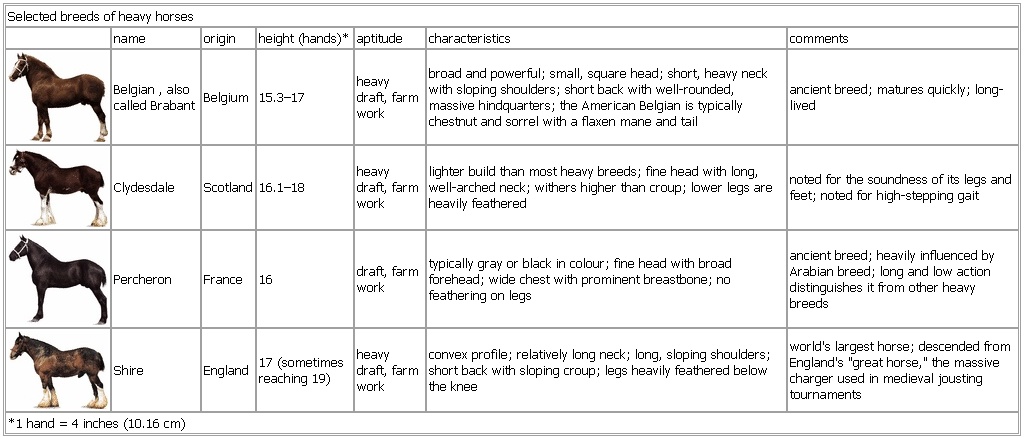Selected breeds of heavy horses
- Selected breeds of heavy horses
-
Selected breeds of heavy horses
name origin height (hands)* aptitude characteristics comments
Belgian (
Belgian horse),
also called Brabant Belgium 15.
3–
17 heavy draft,
farm work broad and powerful;
small,
square head;
short,
heavy neck with sloping shoulders;
short back with well-
rounded,
massive hindquarters;
the American Belgian is typically chestnut and sorrel with a flaxen mane and tail ancient breed;
matures quickly;
long-
lived
Clydesdale Scotland 16.
1–
18 heavy draft,
farm work lighter build than most heavy breeds;
fine head with long,
well-
arched neck;
withers higher than croup;
lower legs are heavily feathered noted for the soundness of its legs and feet;
noted for high-
stepping gait
Percheron France 16 draft,
farm work typically gray or black in colour;
fine head with broad forehead;
wide chest with prominent breastbone;
no feathering on legs ancient breed;
heavily influenced by Arabian breed;
long and low action distinguishes it from other heavy breeds
Shire England 17 (
sometimes reaching 19)
heavy draft,
farm work convex profile;
relatively long neck;
long,
sloping shoulders;
short back with sloping croup;
legs heavily feathered below the knee world'
s largest horse;
descended from England'
s "
great horse,"
the massive charger used in medieval jousting tournaments
*1 hand = 4 inches (10.16 cm)
See as table:
* * *
Universalium.
2010.
Look at other dictionaries:
Horses in warfare — War horse redirects here. For other uses, see War horse (disambiguation). A modern day joust at a … Wikipedia
Heavy warmblood — The Heavy Warmbloods ( de. Schwere Warmblüter) are a group of horse breeds primarily from continental Europe. The title includes the Alt Oldenburg ( Old Oldenburg ), Ostfriese ( East Friesian ), Groningen, and similar horses from Silesia, Saxony… … Wikipedia
horse — horseless, adj. horselike, adj. /hawrs/, n., pl. horses, (esp. collectively) horse, v., horsed, horsing, adj. n. 1. a large, solid hoofed, herbivorous quadruped, Equus caballus, domesticated since prehistoric times, bred in a number of varieties … Universalium
Shire — /shuyeur/, n. one of an English breed of large, strong draft horses having a usually brown or bay coat with white markings. [1875 80; appar. so called because it was bred in the shires, i.e., those counties of west and central England whose names … Universalium
shire — /shuyeur/, n. 1. one of the counties of Great Britain. 2. the Shires, the counties in the Midlands in which hunting is especially popular. [bef. 900; ME; OE scir office of administration, jurisdiction of such an office, county] * * * ▪ breed of… … Universalium
Shiré — /shee ray/, n. a river in SE Africa, flowing S from Lake Malawi to the Zambezi River. 370 mi. (596 km) long. * * * ▪ breed of horse draft horse breed native to the middle section of England. The breed descended from the English “great horse,”… … Universalium
livestock farming — Introduction raising of animals for use or for pleasure. In this article, the discussion of livestock includes both beef and dairy cattle, pigs (pig), sheep, goats (goat), horses (horse), mules (mule), asses, buffalo, and camels (camel … Universalium
Clydesdale horse — Clydesdale Clydesdale draught horse at the Maryland State Fair Distinguishing features … Wikipedia
Silvena Sport — is the name of a sport riding club in Rousse, Bulgaria. It was founded in August 2002 by Krassimir and Ilian Iskarov. Silvena Sport has two principal objectives: to make horse riding a popular sport in Bulgaria, and to foster the growth of the… … Wikipedia
Domestication of the horse — A bred back Heck Horse, closely resembling the Tarpan (photographed 2004), believed to be phenotypically close to the wild horse at the time of its original domestication. There are a number of hypotheses on many of the key issues regarding the… … Wikipedia

